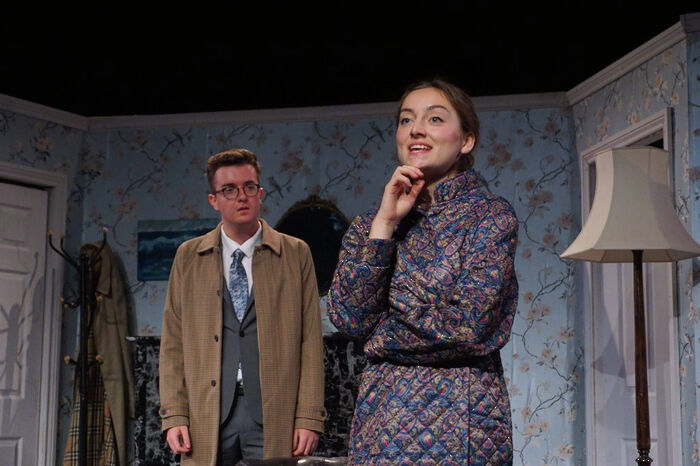Sublime, if ridiculous: Pygmalion‘s achievement is in its satirical lightness
George Bernard Shaw’s parade of socio-linguistic stereotypes is amusingly and effectively brought to Corpus for UCATT’s home run
Freshly returned to the home ground of the Corpus Playroom after touring around China, South Korea, and Japan, the University of Cambridge Asia Theatre Tour revives George Bernard Shaw’s Pygmalion, retracing Eliza Doolittle’s headway from “a squashed cabbage leaf” to a smart-mouthed “work of art”.

The dramatic action unfolds around the poor flower girl Eliza (played by Flora Macangus), and two upper-class phoneticians – Henry Higgins (Sam Tannenbaum) and Colonel Pickering (Archie Williams) – who meet her on a rainy day and bet one another that, in a short period, she will be able to behave like a well-mannered, instructed lady. This challenge leads to some droll scenes presenting Eliza either garbling words or speaking over-formally. As the play progresses, Professor Higgins’s true colours are revealed, he being portrayed as a discourteous person despite his intelligence. While Eliza avoids Higgins and his ill manners, she falls in love with the naïve Freddy (Emily Beck). She does not seem to want the entitled Higgins, preferring the devotion of Freddy – even if he is a spoiled coward.
In this slapstick periplus, Chloe Lansley’s direction carries us along three axes of the play: intellect, conduct and potential. Unlike the romanticised adaptation, the musical “My Fair Lady”, this production puts love in a rather pale light. Instead, it shifts focus on language as a source of bias, on social stratification, and on control, all through humour in both the comic and meant-to-be-serious scenes. This is one of the plays assets; Lansley’s decision to work with satire instead of predictable sentimentalism was the right one. In this way, the performance drew attention the hypocrisy and rudeness of Higgins, who makes fun of others because of his superior social and intellectual status; his brand of humour consists of euphemisms or depreciative remarks chauvinistically addressed to women (“Put her in the dustbin”). In Eliza’s case, humour was found in her struggle to learn and her occasional reversion to old habits, exploiting not only failures in the education system but class stereotypes.
“Lansley’s decision to work with satire instead of predictable sentimentalism was the right one.”
In Pygmalion, characters are barely well-rounded, and this is one of the main reasons portraying them was not at all easy. The toughest case was undoubtedly that of Macangus, as she had to switch in a minute from one linguistic accent or register to another, as well as from a loud and daring flower girl to a vulnerable lady feeling encompassed by Higgins’ influence. Higgins himself was outstandingly played; Tannenbaum had to deal with a really energetic role, and lived up to the task. His mother, played surprisingly naturally by Rory Russell, softened from an initially domineering woman to a sweet senior lady over the course of the play, while Williams’ performance really made Colonel Pickering into Eliza’s “spiritual father”, with the physicality of his hunch and his empathetic tone suggesting the character’s age and wisdom successfully.
Coral Dalitz’s costumes really spoke up in the performance, especially as they were supposed to reflect each character’s social status or personality. Pickering’s yellow suit indisputably depicts his more approachable character. Both he and Higgins are smartly dressed, in accordance to their standing. Throughout the play, Eliza changes her cheap, casual dress into a white, fancier one, as she starts improving her manners and language.
The set comprised parts of Mondrian’s paintings, but to little effect; not all audience members would know the reference, and embedding more elements may have been more redolent. Even if the mise en scène was not necessarily convincing, its mission was taken over by the sound, which had an eloquent role in this play. A few times, it acted as censor to the strong language characters used, in spite of their social position. This was striking, bringing the gravity of these behavioural issues into focus. While ambient sound and music successfully created atmosphere, lights were not taken advantage of enough, their only use being to make the difference between scenes of the play and narratorial interventions.
For the most part, though, the play was outstanding, and the acting was beyond reproach. The few choreographed moments were really appreciated and the show revived Shaw successfully. All in all, UCATT’s Pygmalion really was a work of art.
 News / Cambridge scholarship recipient trapped in Gaza21 July 2025
News / Cambridge scholarship recipient trapped in Gaza21 July 2025 News / Chancellorship candidates express concern about conduct of election 19 July 2025
News / Chancellorship candidates express concern about conduct of election 19 July 2025 News / News in Brief: Chaucer, coffee-houses, and challenging degrees20 July 2025
News / News in Brief: Chaucer, coffee-houses, and challenging degrees20 July 2025 News / Trinity exam burglar jailed for 11 months18 July 2025
News / Trinity exam burglar jailed for 11 months18 July 2025 News / Write for Varsity this Michaelmas13 July 2025
News / Write for Varsity this Michaelmas13 July 2025








